Publications
2022
Wiederkehr, C., Ide, T., Seppelt, R., Hermans, K. 2022. It's all about politics: Migration and resource conflicts in the global south. World Development, vol. 157.
Short summary:
Both researchers and policy makers have repeatedly expressed concerns that migration will enhance conflicts regarding renewable resources in destination areas. This concept is fuelled by projections of large future migration flows within the Global South, resulting from armed conflict, global environmental change, and persistent economic inequalities. However, as of yet, there is no conclusive empirical evidence of a nexus between migration, resource competition, and conflict at an aggregate level. Case studies draw contradicting conclusions, and cross-case research on the topic remains scarce. Here, we combine comprehensive qualitative and quantitative data from 20 cases in rural Asia, Latin America and Sub-Saharan Africa. Based on these cases, we investigate why certain areas hosting migrants have resource-related conflicts, while others do not. Using qualitative comparative analysis (QCA), we evaluate and elucidate two combinations of conditions under which resource conflict involving migrants in destination areas occurs: (1) high reliance on natural resources and negative othering of migrants in terms of resource use, and (2) government policies supporting parts of the migrant group coupled with limited resource use possibilities due to conservation efforts or industrial activities. By underlining the crucial role of grievances related to perceived unfair resource access and the strong influence of government actions on local migrant-host dynamics, we challenge deterministic narratives of migration, resource scarcity and conflict.
Sample of cases under study and type of renewable resource(s) concerned. Info boxes referring to conflict cases are highlighted in bold. (Wiederkehr et al. 2022)
2021
Hermans, K., Berger, E., Biber-Freudenberger, L., Bossenbroek, L., Ebeler, L., Groth, J., Hack, J., Hanspach, J., Hintz, K.S., Kimengsi, J.N., Kwong, Y.M.C., Oakes, R., Pagogna, R., Plieniger, T., Sterly, H., van der Geest, Kees, van Vliet, J. & Wiederkehr, C. 2021. Crisis-induced disruption in place-based social-ecological research - an opportunity for redirection. GAIA, vol. 30/2.
Short summary:
Place-based research faces multiple threats, including both natural and global health hazards and political conflicts, which may disrupt fieldwork. The current COVID-19 pandemic shows how these threats can drastically affect social-ecological research activities given its engagement with different local stakeholders, disciplines, and knowledge systems. The crisis reveals the need for adaptive research designs while also providing an opportunity for a structural shift towards a more sustainable and inclusive research landscape.
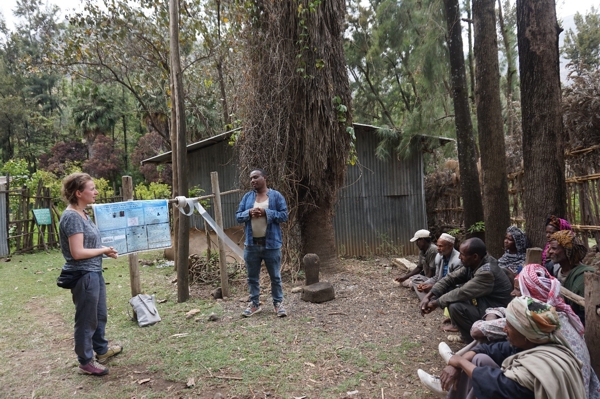 Group discussions, such as this one in the northern Ethiopian highlands within the scope of the research group MigSoKo are not possible during the COVID-19 pandemic. Crises like the current pandemic can impede participatory place-based research methods, consequently calling for alternative approaches. (Hermans et al. 2021)
Group discussions, such as this one in the northern Ethiopian highlands within the scope of the research group MigSoKo are not possible during the COVID-19 pandemic. Crises like the current pandemic can impede participatory place-based research methods, consequently calling for alternative approaches. (Hermans et al. 2021)
Hermans, K. & McLeman, Robert. 2021. Climate Change, drought, land degradation and migration: exploring the linkages. Current Opinion in Environmental Sustainability, vol 50.
Short summary:
Droughts are significant drivers of land degradation, which in turn has adverse effects on resource-dependent rural populations and can potentially lead to livelihood losses and subsequent migration out of affected areas. Linkages between land degradation and migration are complex and not particularly well documented, as they occur within a larger context of multi-scale interactions of socio-economic, political, demographic, and environmental processes. Given these uncertainties, further research in this field is needed. Here, we review existing research on how droughts affect land degradation-migration dynamics, and illustrate the pathways by which migration is affected by and responds to the climatic driver. We pay particular attention to methods used to identify, measure, and understand migration related to land degradation – including statistical approaches, application of remote sensing data and qualitative approaches – and identify common challenges encountered by researchers. We conclude by identifying future directions and priorities for research.
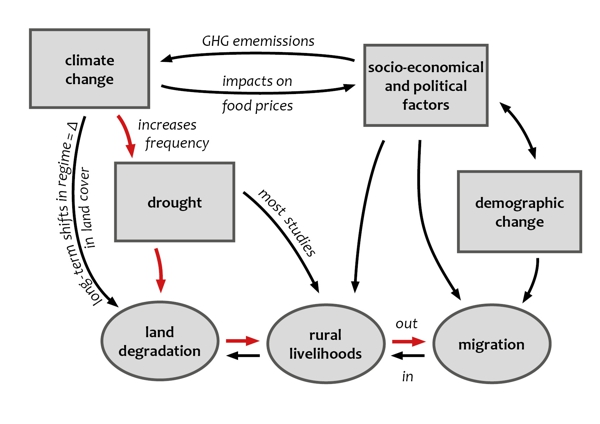 Causal linkages between climate change, drought, land degradation and migration (Hermans & McLeman 2021)
Causal linkages between climate change, drought, land degradation and migration (Hermans & McLeman 2021)
Groth, J., Hermans, K., Wiederkehr, C., Kassa, E. & Thober, J. 2021. Investigating environment-related migration processes in Ethiopia - A participatory Bayesian network. Ecosystem and People, vol. 17.
Short summary:
The influence of environmental change on human migration is complex. Despite major strides in understanding the environment’s role in migration processes, uncertainties associated with multi-scale factor interactions and their influence on migration still persist. This study aims to (a) understand how soil degradation and rainfall changes – in combination with socio-economic factors – in the northern Ethiopian highlands contribute to human decisions to migrate; and (b) identify barriers for adopting local policy measures to reduce migration needs. Therefore, we integrate place-based research with literature findings and the participatory development of a Bayesian network (BN) involving local policy makers and representatives from both villages and NGOs. Our results show two major influential factors that affect environment-related migration: (a) the sufficiency of a household’s agricultural production and (b) non-farm activities. According to our participatory BN, we conclude that environmental changes increase migration, either through high migration needs due to low agricultural production and/or through increased non-farm activities, which increases the necessary financial means to enable migration. We conclude that contradicting policy programs greatly hinder local measures to prevent soil degradation, potentially fueling migration, and that bottom-up and locally adapted strategies are particularly promising for sustainable land management in the region.
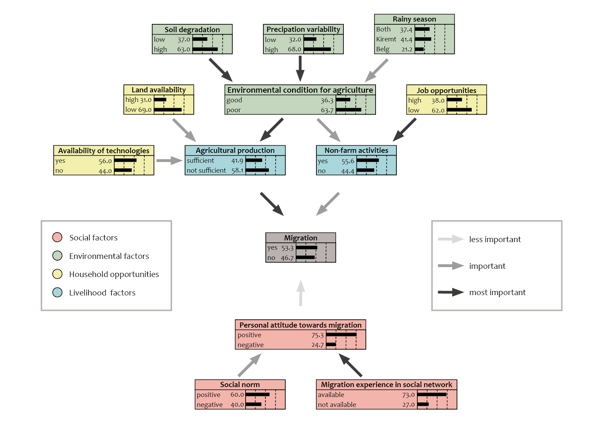 The Bayesian Network of the current state of environment-related migration of subsistence farmers in South Wollo (Groth et al. 2021)
The Bayesian Network of the current state of environment-related migration of subsistence farmers in South Wollo (Groth et al. 2021)
2020
Groth, J., Ide, T., Sakdapolrak, P., Kassa, E. & Hermans, K. 2020. Deciphering interwoven drivers of environment-related migration - A multisite case study from the Ethiopian highlands. Global Environmental Change, vol. 63.
Short summary:
Global environmental change is increasing livelihood pressure for many communities, and agricultural households in the Global South are particularly vulnerable. Extant research has debated whether and to what degree this amplifies migration flows while also acknowledging that migration can be an adaptive strategy. However, little is known about which contextual factors are most relevant and how they interact in shaping environment-related migration. We shed light on this issue by conducting an in-depth qualitative, yet multisite and medium-N study of farming households in the northern Ethiopian highlands. We utilized qualitative comparative analysis (QCA) – a novel approach in the research field – to overcome the existing methodological challenges. We found that the migration experience within the household in combination with either the usage of the longer summer rainy season (Kiremt) or non-farm in situ diversification are sufficient causes for migration. Non-farm income activities and favorable environmental conditions during the Kiremt season increases economic household resources and as such migration ability. However, only together with migrant networks, which can reduce the costs and risks of migration and shape migration aspirations, can these drivers explain why households engage in migration. Our findings reveal that capabilities and networks, rather than commonly cited push factors, are far more important drivers of environment-related migration at the household level. Additionally, we illustrate that while migration is an important adaptation strategy, it cannot be adopted equally among households and as a result often reinforces existing inequalities.
(Groth et al. 2020)
Wiederkehr, C., Schröter, M., Adams, H., Seppelt, R. & Hermans, K. 2019. How does nature contribute to human mobility? A conceptual framework and qualitative analysis. Ecology and Society, vol. 24.
Short summary:
Different types of mobility are known as longstanding strategies used by
humans to deal with environmental pressure. Immobility is relevant in
this context as population groups may be at considerable risk but
lacking the capacity or willingness to move. Despite significant
advances in this research field, grasping especially the subjective
dimension of people’s migration decision remains challenging. Moreover,
the conceptualization of cultural factors in this context has received
rather marginal attention thus far. In light of this, we propose a
framework that integrates the novel concept of nature’s contributions to
people (NCP) with migration theory, in particular the triad of
migration need, ability, and aspiration. NCP goes beyond the popular
notion of ecosystem services by conceiving nature-society relations in a
more inclusive way with culture being a key element of these. Combined
with migration need, ability, and aspiration, we argue that this
approach offers a valuable nuanced perspective on nature-mobility
interactions, including cultural aspects of natural resource use and
varying degrees of agency related to mobility decision making. We apply
the framework to two archetypal climate-related migration situations,
southwestern coastal Bangladesh and the northern Ethiopian highlands, to
delineate the diverse mechanisms through which environmental change
shapes population movement in highly resource-dependent livelihoods. We
show that based on the analyzed case studies most links can be drawn
between material and regulating NCP and migration need, and that
nonenvironmental factors play a crucial role in mediating nature’s
contributions to human mobility. More knowledge is needed though in
particular on the influence of nonmaterial NCP on mobility decision
making and on migration aspirations in general to better account for
important cultural factors. We formulate a number of hypotheses and
questions relevant for guiding future research that can inform policy
interventions.
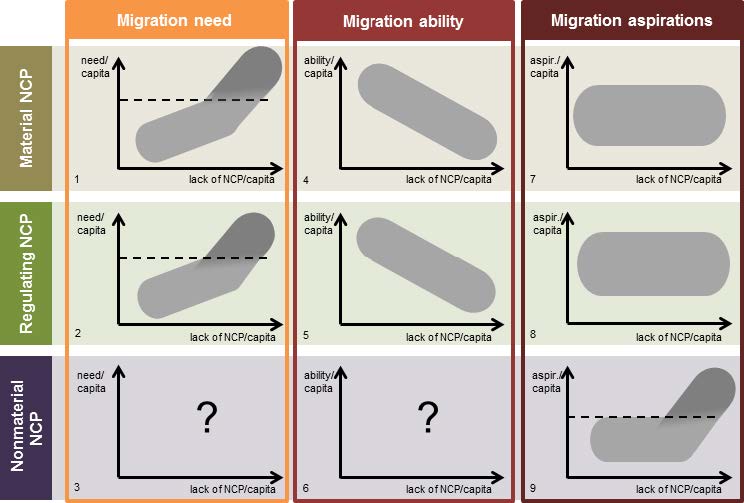 Hypothesized “direction” of the linkages between nature’s contributions to people (NCP)/capita and migration need, ability, and aspiration. (Wiederkehr et al. 2019)
Hypothesized “direction” of the linkages between nature’s contributions to people (NCP)/capita and migration need, ability, and aspiration. (Wiederkehr et al. 2019)
2019
Hermans, K. & Garbe, L. 2019. Droughts, livelihoods and human migration in Northern Ethiopia. Regional Environmental Change, vol. 19.
Short summary:
Our study examines the effects of drought on livelihoods and human migration in the rural highlands of northern Ethiopia, one of the most affected regions during the 2015 drought. We conducted a household survey contextualized by focus group discussions in two rural sending areas. Drought intensity was similar in both areas, but drought impacts and farmer’s response strategies differed. Overall, we observed significant strategy changes, including a drastic shift from subsistence crop production to livestock sale among farmers being dependent on the March–June rainfall (belg season). Our results suggest that drought increases mobility, primarily through triggering short-term migration to closer destinations to cover immediate needs like food shortages. Four out of ten households in both regions engaged in migration. Nonetheless, migration tends to be context specific with respect to barriers and opportunities for participation, with distance, duration, and perceptions of migration as well as the underlying motives being region-specific. We conclude that understanding livelihood strategy changes requires an embedding in a larger context rather than focusing on one particular driver. Migration—one important livelihood strategy in northern Ethiopia—is the result of a complex interplay of factors, drought perhaps being only one of them. Based on our finding, we reason the decision to migrate is strongly moderated by the drought rather than it is directly driven by it.
Location map of the two research sites Abasokotu and Guguftu in South Wollo (Hermans & Garbe 2019)
Hermans, K. & Ide, T. 2019. Advancing research on climate change, conflict and migration. Die Erde, vol. 150.
Short Summary:
Policy makers across the entire globe have repetitively expressed concern about climate change as a trigger of mass migration and increased political instability. Recent research on both climate-conflict and climate migration linkages has gained significant attention in the scientific and public debate. Both research fields are deeply intertwined and share some common characteristics. They also have been rapidly evolving during the past years with major achievements being made. Perhaps most importantly, an improved understanding of the role of (potential) climate change impacts in migration and conflicts has been achieved, which has been essential for moving beyond environmental determinism toward a more nuanced exploration of the interlinkages between climate, conflict and migration. Yet, significant conversations and uncertainties continue to exist, hence indicating the urgent need for further advances in these fields. Here, we debate cross-cutting and common pitfalls in both research fields and their implications for policy and research. These pitfalls include (i) insufficient attention to context factors and causal chains, (ii) underestimation of complex spatio-temporal patterns, (iii) discrepancies between quantitative and qualitative evidence, (iv) the non-consideration of adaptation strategies, and (v) a narrow spectrum of methods. We illustrate best practices and suggest ways to move the debate forward.
(Hermans & Ide 2019)
2018
Wiederkehr, C., Beckmann, M. & Hermans, K. 2018. Environmental change, adaptation strategies and the relevance of migration in Sub-Saharan drylands. Environmental Research Letters, vol. 13.
Short summary:
Understanding coping and adaptation behaviour of different population groups in the context of global environmental change has become increasingly important, especially in regions with high vulnerability such as Sub-Saharan drylands. In this regard, household strategies tend to be dependent on local and context-specific conditions. However, the strategic development of climate change adaptation measures, as well as natural resource and migration management on national and international level require transferable results and recommendations. In this paper, a first attempt is made to address the lack of meta-knowledge and to create a bigger trans-regional picture on the topic. It provides an exploratory and systematic synthesis of quantitative and qualitative data from 63 studies covering more than 9700 rural households from Sub-Saharan African drylands. Relevant household coping and adaptation strategies under different types of environmental change are assessed with a particular focus on the role and relative significance of migration. The results demonstrate that strategies related to crop, livestock, soil and water management are, by far, the most common. Yet, various forms of migration are reported as strategy by about 23% of the households. Corroborated by qualitative findings, this emphasises the importance of migration for responding to unfavourable environmental conditions at the household level. Based on the synthesised literature, future directions for research needed to support socially and ecologically sustainable coping and adaptation are provided.
(Wiederkehr et al. 2018)
Thober, J., Schwarz, N. & Hermans, K. 2018. Agent-based modeling of environment-migration linkages: a review. Ecology & Society, vol. 23.
Short summary:
Agent-based models (ABMs) are valuable tools to study the linkage between environment and migration because they can represent individual migration decisions of human actors. There is an increasing, yet small, number of ABMs that consider the natural environment in rural migration processes. In this study we reviewed 15 agent-based models of environment-migration linkages in rural contexts. We found that the representation of environmental factors in ABMs is often limited and that the linkage between environment and migration is often depicted only as one-way influence without considering the impact of migration on the environment. We recommend that future model developments should engage in representing environmental factors more thoroughly as well as incorporating fully integrated feedbacks between the social and the environmental system.
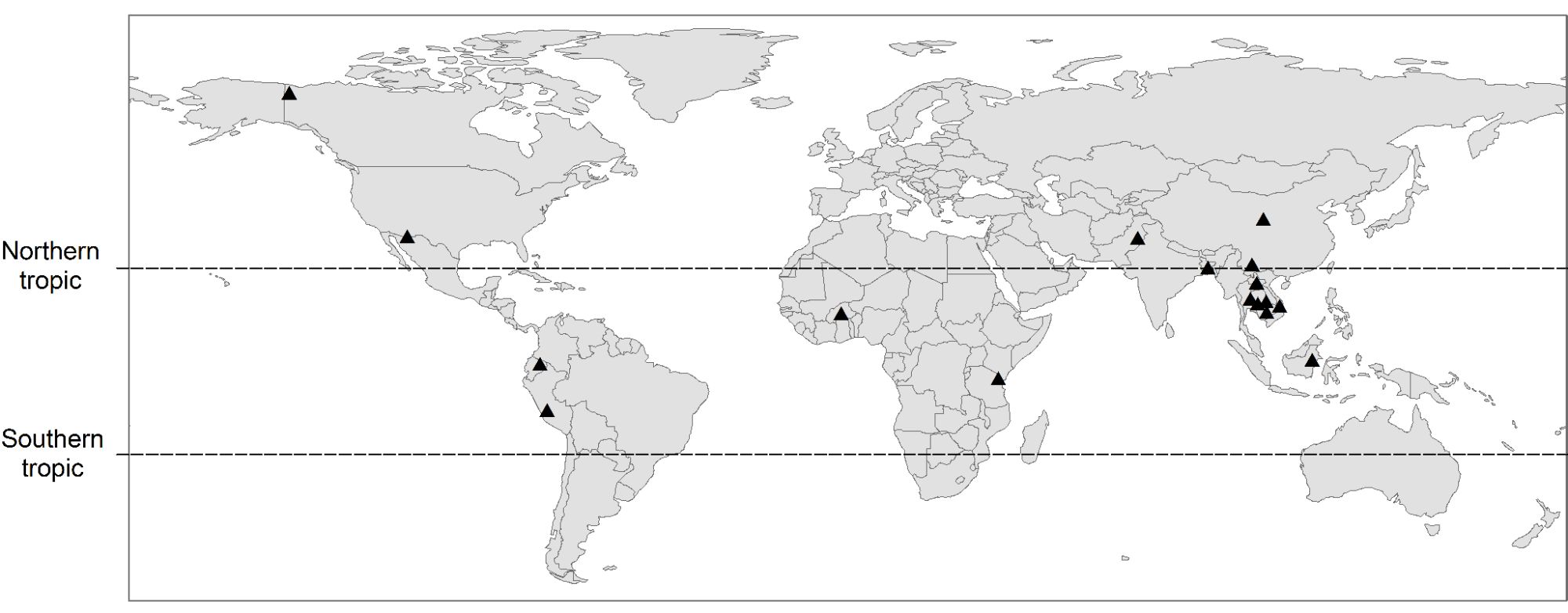 Global distribution of model applications (Thober et al. 2018)
Global distribution of model applications (Thober et al. 2018)
2017
Hermans-Neumann, K., Priess, J. & Herold, M. 2017. Human migration, climate variability, and land degradation: hotspots of socio-ecological pressure in Ethiopia. Regional Environmental Change, vol. 17.
Short summary:
In Ethiopia, human migration is known to be influenced by environmental change—and vice versa. Thus, degradation of environmental conditions can contribute to out-migration, and in-migration can cause environmental changes at the immigrants’ destination. The aim of our study was to systematically identify regions in which socio-ecological pressures can arise from high population densities, migration, land degradation, and/or rainfall variability. We combined population census data at the district level with high-resolution remote sensing data regarding rainfall variability, land degradation, and land cover. We identified districts in which high population density is coupled with both a steep decline in net primary production (NPP) and large precipitation variability. The affected regions are mainly cropping regions located in the northern highlands and in the central part of the Great Rift Valley. We consider these regions to be particularly prone to environmental changes; moreover, high population density places additional stress on local natural resources. Next, we identified districts in which high in-migration is coupled with both a strong decline in NPP and low rainfall variability, proposing that land degradation in these regions is likely to have resulted from human activity rather than climatic factors. The affected regions include parts of the Awash Valley, regions surrounding Lake Tana, and the mountainous regions between Addis Ababa, Bedele, and Jima. We found these hotspots of in-migration and land degradation are dominantly grasslands regions, which have been characterized by significant cropland expansion during the period studied. Whereas exploring causal relationships between migration, environmental change, and land cover change is beyond the scope of our study, we have pinpointed regions where these processes coincide. Our findings suggest that at the regional scale, deteriorating environmental conditions can be both the cause and the effect of migration.
Hotspots of potential out-migration and in-migration (Hermans et al. 2017)

